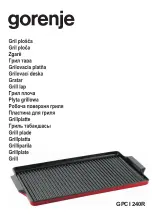
Installation and Maintenance Instructions for
Intelligent Plug-in Model FST-751 Thermal Sensor
GENERAL DESCRIPTION
Model FST-751 is an intelligent sensor that uses a state-of-the-art thermistor sensing circuit for fast response. This sen-
sor is designed to provide open area protection with 50 foot spacing capability, and is intended for use with compatible
control panels only.
Two LEDs on each sensor light to provide a local, visible sensor indication. Remote LED annunciator capability is avail-
able as an optional accessory (Part No. RA400Z).
Notifier panels offer different feature sets across different models. As a result, certain features of the FST-751 may be
available on some control panels, but not on others. The sensor will support either FlashScan™ or CLIP (Classic Loop
Interface Protocol) mode. The possible features available in the FST-751, if supported by the control unit include:
1. The panel controls the LED operation on the sensor. Operational modes are RED blink, RED continuous, GREEN blink,
and off.
2. The remote output may be synchronized to the LED operation or controlled independent of the LEDs.
Please refer to the operation manual for the UL listed control unit for specific operation of the FST-751.
SPECIFICATIONS
Diameter: 6.1 inches (155 mm) installed in B710LP
4.1 inches (104 mm) installed in B501
Height: 2.0 inches (51 mm)
Weight: 5 ounces (150 gm)
Installation Temperature: –4°F to 100°F (-20°C to 38°C)
Operating Humidity Range: 10% to 93% Relative Humidity Noncondensing
Mounting: B710LP flanged base
B501 flangeless base
Voltage Range: 15 to 32 Volts DC Peak
Standby Current: 300
µ
A @ 24 VDC (one communication every 5 sec.with LED blink enabled)
LED Current: 6.5 mA @ 24 VDC
Fixed Temperature Setpoint: 135°F (57°C)
WIRING GUIDE
Refer to the installation instructions for the plug-in base being used. Bases are equipped with screw terminals for power, ground,
and remote annunciator connections. See Figure 1. Bases B710LP (shown in Figure 1) and B501 are electrically identi-
cal.
NOTE: All wiring must conform to applicable local codes, ordinances, and regulations.
NOTE: Verify that all sensor bases are installed and that the wiring polarity is correct at each base.
WARNING: Disconnect the power from the loop before installing sensors.
Before installing sensors, please thoroughly read the system wiring and installation manual, which provides detailed
information on sensor spacing, placement, zoning, and special applications. Copies of these manuals are available from
Notifier. NFPA standard 72 should also be referenced.
N500-55-00 1 I56-1234-05R
Notifier, 12 Clintonville Rd, Northford, CT 06472
N500-55-00 4 I56-1234-05R
© 2001 Notifier
FCC Statement
This device complies with part 15 of the FCC Rules. Operation is subject to the following two conditions: (1) This device
may not cause harmful interference, and (2) this device must accept any interference received, including interference
that may cause undesired operation.
Note: This equipment has been tested and found to comply with the limits for a Class B digital device, pursuant to Part 15
of the FCC Rules. These limits are designed to provide reasonable protection against harmful interference in a resi-
dential installation. This equipment generates, uses and can radiate radio frequency energy and, if not installed
and used in accordance with the instructions, may cause harmful interference to radio communications. However,
there is no guarantee that interference will not occur in a particular installation. If this equipment does cause harm-
ful interference to radio or television reception, which can be determined by turning the equipment off and on, the
user is encouraged to try to correct the interference by one or more of the following measures:
– Reorient or relocate the receiving antenna.
– Increase the separation between the equipment and receiver.
– Connect the equipment into an outlet on a circuit different from that to which the receiver is connected.
– Consult the dealer or an experienced radio/TV technician for help.
Please refer to insert for the Limitations of Fire Alarm Systems
www.PDF-Zoo.com




















